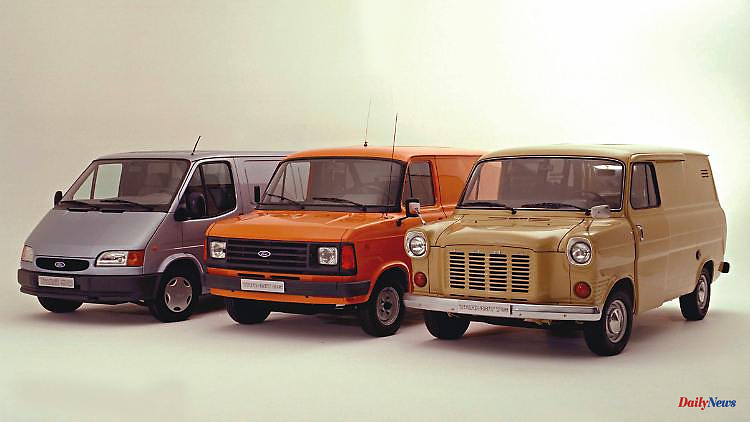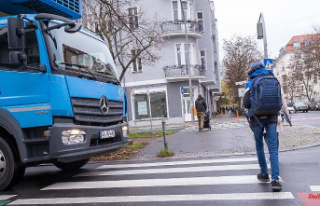In fact, it was the designer of the VW Bulli who brought the Ford Transit forerunner FK 1000 into shape in 1952. As "express freight", the Cologne box gently nibbled at the market share of the Wolfsburg bestseller, only to finally overtake the Bulli as a transit in Europe after 1965.
Who doesn't know them, the little all-rounders Ford Transit and VW Bulli? Light commercial vehicles, which played a major role in the Europe of the economic miracle as panel vans and campers. But hardly anyone knows that this duo has the same father: designer Alfred Haesner first finalized the VW T1, then in 1952 he designed the Transit forerunner FK 1000 and marketed it as an express freighter in the following year, until this VW pursuer mutated into a Transit in 1965 and established itself as the European market leader among the light "utility". In terms of cult status, the Bulli is further ahead, but the Transit has also long since achieved legendary status.
Even in the construction era, the Ford FK 1000 caused a sensation as the fastest panel van, from the swinging sixties onwards, many pop bands put their trust in the Transit's tour bus talents, and finally Scotland Yard declared the dashing Ford the most wanted van in Great Britain: "In 95 percent of all bank robberies the perpetrators in transit," said a police spokesman in 1972. Ford immediately promoted this need-for-speed image with supervans for world speed records.
In the 21st century, the Transit grew into a model family in four sizes, only to discover the topic of electrification. The Transit Custom has been available as a plug-in hybrid since 2019, and the E-Transit will follow on the 70th anniversary of the Ford van. Above all, the Transit Connect starts as the first child of a cooperation with VW, which will also create a common platform for future Transit and Bulli generations.
This comprehensive cooperation with Volkswagen, signed in 2020, was certainly not something that CEO Henry Ford II could have imagined when he said "No!" after the Second World War. declined the offer of the victorious Allied powers to run the Wolfsburg plant independently. On the other hand, in those dark post-war days, arch-rivals Ford and VW began to work together for the first time, because in 1948 the relaunched Ford Taunus was initially assembled at the Wolfsburg plant.
Right next door, Alfred Haesner designed the Volkswagen Transporter T1, but he had to take into account the Beetle design with a rear engine that was too weak for heavy loads, delivering 25 hp. Haesner, who switched to Ford Cologne in 1952, found the engine from the Taunus 12 M limousine, with its powerful 38 hp, all the more exciting, which got the modern Ford FK 1000 pack donkey going.
FK 1000, this type code stood for Ford Cologne and a proud 1000 kg payload (compared to 750 kg for the first VW T1), but the model designation also inspired the advertising slogan "The fire brigade drives 100 things" and the term express freighter. The media used it as the "raging room", but also quickly recognized the Achilles' heel of the furious Ford.
The light truck from Cologne, which was fitted out by the coachbuilder Drauz in Heilbronn, suffered from a structural weakness that the developer Haesner and the chief engineer Alfons Streit had accepted in favor of maximum loading volume. When unloaded, the FK 1000 was top-heavy due to the front engine placed very far in front and then hopped unwillingly over streets, especially since these often had cobblestones.
Only a modified platform made it possible to move the four-cylinder towards the cockpit and thus a smoother ride. Now the sales figures for the transporter, called the Taunus Transit from 1960, climbed to new heights, albeit mainly in Germany. The comparison with competitors from the Borgward Group, from Tempo or DKW, was positive, but the Bulli, which sold global VW from the start, played in a higher league: 255,832 Transit vs. 1,535,595 Volkswagen Transporters was the conclusion in 1965 when the first Transit gave way to a new generation.
Henry Ford II personally pushed the successor as a global project. "Little Red Riding Hood" (English: "Redcap") was the code name for the new Transit, which was designed at Ford's American headquarters and then made ready for series production in Germany and Great Britain. In fact, this Transit, which was later sold worldwide, revolutionized the transport segment from 1965 with over 50 different extension and body variants, optional diesel engines and as a cult box for the family, leisure time or pop bands. For many Ford employees in Cologne, the comfortable loading giant was the family car of choice when they went to their Turkish homeland during the factory holidays. It is not without reason that the Transit plant in Kocaeli (Turkey) has been one of the most important production sites for the bestseller, which had sold five million times by then, since 2004.
The useful Ford was also able to release plenty of emotions right from the start. Be it on race tracks as a 240 km/h galloping wild rider with the Le Mans engine of the Ford GT (from 1972), as a 270 km/h fast Supervan 2 with a caravan on the hook (1985), as a Transit Supervan III (1995) with a 485 kW/650 hp Cosworth V8 from Formula 1, an unglazed panel van that completed stunt jumps over 15 cars (from 1972) or as a seaworthy amphibious vehicle for enjoyable English boat races (from 1980).
Then there were the headline-generating photos of Transit as a mobile home for elephants (1965), of Transit's regular bus service on the London-Australia marathon distance (16,000 kilometers) and the relaxation buses of bands like The Tremeloes, Status Quo or Coldplay. Not to forget the appearance of the spectacular, 7.40 meter long Transit stretch limousine (2007) or that white Transit van desperately wanted by paparazzi, which the British royals William and Kate used for incognito tours during their engagement in Anglesey in 2013.
In addition, there were dynamic models such as the Transit Sport from 2006, the first production panel van with Le Mans decor, or the nugget in the popular campervan club. The Transit should be one for all from the beginning and this is reflected in the seven Transit generations to date. From 2012, the three formats Transit Courier, Transit Connect and Transit Custom supplemented the range below the full-size Transit, which now competes with the VW Crafter or Mercedes Sprinter.
In addition, the passenger car versions Tourneo Courier to Custom complete the portfolio - since even some Ford dealers lose track. Ford has thus confidently secured the crown of the class leader as the most successful brand of light commercial vehicles since 2014, not only Volkswagen, but also the emerging competition from Mercedes, Peugeot, Citroën and Fiat.
From the early express truck to the modern family and leisure vehicle, the Transit wrote a similar amount of everyday history as the vans from VW. In the future, this will happen together, from 2023 even the commercial vehicle version of the VW T7 Bulli will share the basis with the next Transit Custom: Everything will be different and at the same time the two will remain best friends and enemies on the market.
6












